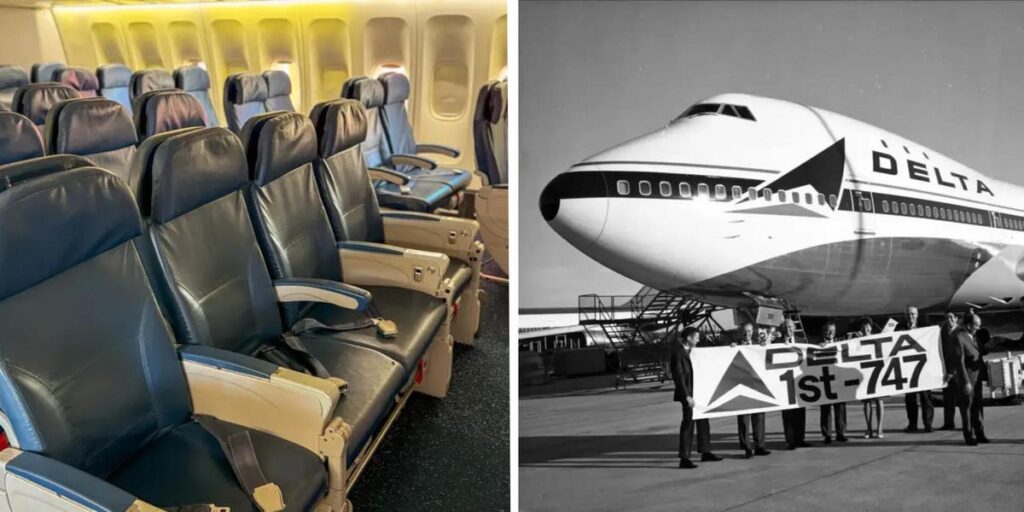subscribers. Become an Insider
and start reading now.
Have an account? .
- A Boeing 747 is one of the most popular exhibits at the Delta Flight Museum in Atlanta.
- This particular plane was the first Boeing 747-400 ever made and entered service in 1989.
- The jet flew for Delta until 2015 and became a museum exhibit in 2017.
The Boeing 747 is one of the most famous planes in aviation history. But newer, more efficient twin-engine airliners have relegated the Queen of the Skies to retirement or to flying cargo.
With no US airlines operating scheduled passenger service using a 747, the easiest way for many people to see a jumbo jet in person is to visit The 747 Experience at the Delta Flight Museum in Atlanta.
I recently had the chance to tour the freshly renovated Delta Flight Museum and its Boeing 747.
The 747 looms large over the entrance gate to Delta’s Flight Museum.
The museum is housed in a pair of historic hangars at Delta Air Lines headquarters on the northern edge of Atlanta’s airport.
Despite its prominent position at the museum, the 747 was actually a minor player in Delta’s century-long history.
The carrier took delivery of its first Boeing 747-100 in 1970 but soon realized that a smaller widebody like the Lockheed L-1011 would better suit its needs. As a result, Delta had returned all five of its 747-100s back to Boeing by 1977.
Delta would not operate the 747 again until 2008.
The 747 preserved at the museum, N661US, known within Delta as Ship 6301, is an important piece of aviation history.
Despite being Boeing’s 696th jumbo jet, it was the first upgraded 747-400 to be built. The -400 was a major step forward for the 747 as it not only increased range and performance but also introduced modern technology like digital instrument displays and more powerful flight computers, eliminating the need for a flight engineer.
The -400 dominated the skies during the 90s and early 2000s, accounting for roughly half of the more than 1,500 747s produced during its five-decade-long run.
Ship 6301 served as the prototype for the 747-400 and made its first flight on April 29, 1988.
Pratt & Whitney then used the aircraft as a test bed for its PW4000 series engines, which would power all of Delta’s 747-400s.
The plane entered commercial service with Northwest Airlines in December 1989.
Ship 6301 joined the Delta fleet in 2008 following its merger with Northwest. The jet logged more than 61 million miles before retiring from service in September 2015.
Delta’s entire 747 fleet was retired by the end of 2017.
Following its retirement, Delta turned the jumbo jet into a permanent fixture at its headquarters.
The 747 Experience opened in March of 2017 as a museum exhibit and event space.
From the museum parking lot, you approach the rear of the aircraft.
The entrance to the 747 Experience is at the front of the aircraft, right past its port wing.
Here are a couple of its Pratt & Whitney engines.
Each one of its four PW4056 turbofan engines produces 57,000 lbs of thrust, helping a full-loaded 747-400 fly nearly 7,000 miles.
A short elevator ride takes up to the boarding door.
Part of the plane’s cabin remains intact, while other parts have had its walls and ceiling removed.
Take a left turn toward the front of the plane and you’ll find seats rows of economy class seats.
When it was in service, the plane was configured to carry 376 passengers, of whom 328 were in its Economy and Economy Comfort cabins.
At the nose of the aircraft is its first-class cabin.
These Zodiac Aerospace flatbed seats are a predecessor to today’s Thompson Vantage XL DeltaOne suites.
The 747’s front galley has been preserved as well.
The aircraft’s galleys, the economy cabin, and the upper deck have been removed.
Walk up the stairs to reach the 747’s iconic upper deck.
The 747-400 has a stretched upper deck with greater seating capacity than the original 747-100/200 series.
While the upper deck of Delta’s original 747s had luxury lounges, there are just more DeltaOne seats.
The aircraft operated with a total of 48 DeltaOne seats onboard across two decks.
At the front of the upper deck is the 747’s cockpit.
This is the first version of the 747 to operate with a two-person crew without a flight engineer.
Right behind the cockpit is the pilot crew rest bunks.
Due to the long trans-oceanic routes the aircraft flew, it usually operated with at least one relief pilot who took over flying duties when one of the main crew rested.
There’s a glass partition at the back of the upper deck showing the main deck below.
The partition also reveals the cables that physically connect the pilot’s yoke to the plane’s control surfaces.
The main economy class cabin has been stripped bare to reveal the inner workings of the aircraft.
The walls are covered by displays on the aircraft’s history.
Parts of the floor have been replaced by glass panels.
This section gives museumgoers a view of the jet’s air conditioning system.
Further back, there is another glass floor section showing the aircraft’s cargo compartment.
The 747 was designed to be able to carry cargo as well as it does passengers. In fact, some airlines have even ordered 747 Combi models that haul cargo on the main deck behind the passenger compartment.
At the very of the cabin is the plane’s exposed pressure dome.
The dome is the end cap that helps keep the cabin pressurized.
Next to the pressure dome is the entrance to the stairs that lead to the plane’s flight attendant crew rest.
The crew rest compartment is comprised of a series of bunks immediately above the aft passenger cabin.
For those looking for some fresh air, there is an observation platform over the starboard wing.
Access to the 747 Experience is included in the general admission ticket to the museum.
Read the full article here
















